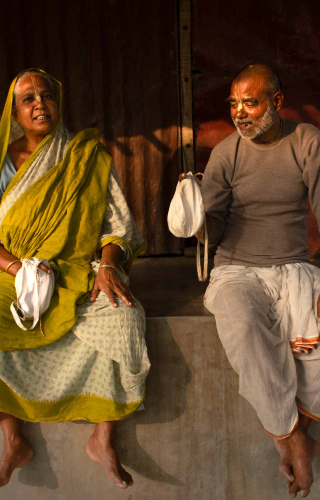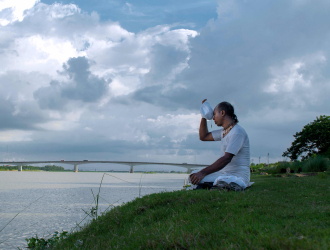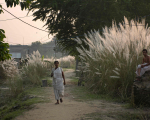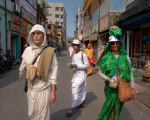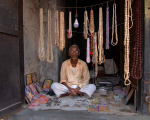Located on the west bank of the river Bhagirathi, Nabadwip is estimated to be a thousand-year-old town. Nabadwip was once a revered centre for Sanskrit education and has produced many prominent philosophers, scholars and monks. The great Vaishnava spiritual teacher and icon of the Bhakti movement, Sri Chaitanya Mahaprabhu (1486–1534) was born in Nabadwip. He founded Gauḍiya Vaishnavism and his mode of worshipping Sri Kṛishna and Radha brought about the resurgence of Vaishnava culture at Nabadwip and helped spread the Bhakti movement in Bengal, Puri and Vrindavan.
But following the death/disappearance of Sri Chaitanya, conservative Brahminism re-established itself in Nabadwip. For more than 200 years, Gauḍiya Vaishnavism progressively declined in Nabadwip. Meanwhile, in 1759, Meitei King Bhagyachandra (Ching-Thang Khomba) ascended the throne in Manipur. He became a staunch Gauḍiya Vaishnavite and patronised it in Manipur. In later years of his life he visited Nabadwip and founded the temple of Anumahaprabhu at Tegharipada mouja. Before the arrival of Raja Bhagyachandra, Vaishnava saint Totaram Das Babaji had founded a temple where the idol installed is carved from the neem tree which was worshipped by Vishnupriya Devi, second wife of Sri Chaitanya. Diwan Ganga Govinda Singha also founded a temple at the birthplace of Sri Chaitanya. The combined religious-cultural patronage of Raja Bhagyachandra, Totaram Das Babaji and Diwan Ganga Govinda Singha contributed towards the revival of Gauḍiya Vaishnavism in Nabadwip.
In Nabadwip, the impact of Gaudiya Vaishnavism is visible everywhere. Devotees across the world throng the headquarters of ISKCON (International Society for Kṛṣṇa Consciousness) at Mayapur, which is on the other side of the river. Vaishnavites frequently visit Nabadwip too. Gauḍiya Vaishnavites are easily identified with their shikha or tiki (lock of hair left on the back of the shaven head), attire, marking of tilaka on forehead and other parts of body, tulsi kanthimala (worn in double or triple layer) and japamala bag in hand.
Chaitanya Mahaprabhu’s devotees consider him an incarnation of Sri Krishna. Chaitanya’s Bhakti-Yoga was derived from pure love for Sri Krishna and his various avatars. This love is expressed through nama sankirtana, kirtana (congregational chanting) of nama (name) of the Supreme (Sri Krishna). This mode of worshipping Kṛiṣhṇa and the religious teachings of Mahaprabhu was widely accepted by the common folk regardless of caste, race and religion. Chaitanya believed one can experience the Supreme Truth through rasa. Rupa Goswami, a contemporary of Chaitanya Mahaprabhu, poet and noted philosopher of Gaudiya Vaishnava tradition, articulated rasa as ‘the soul's particular relationship with the divinity in devotional love.’ This relationship is achieved by japa—meditative repetition of the name of Sri Krishna.
Muttering of japa is accompanied by counting a japamala (prayer beads). The japamala is made from the tulsi wood. Set in a loop, a japamala consist of 108 beads, a sacred number in Hinduism considered perfect and complete. While pushing each bead downwards, the 16-word mahamantra is recited ‘Hare Krishna Hare Krishna /Krishna Krishna Hare Hare/Hare Rama Hare Rama/Rama Rama Hare Hare.’ The 109th bead is called the sumeru (also bindu, guru bead or mother bead) and is larger or made of a distinct material which can be sensed by touch.
A second type of mala used by Gauḍiya Vaishnavas is the kanthimala, also made of tulsi wood, which is worn around the kantha (neck) and must touch the skin of the wearer. Kanthimalas can be made of flat or cylindrical beads and are plain, but japamalas are made of spherical beads and can be decorative. Vaishnava symbols like Radha-Krishna motif, Hare-Krishna in Bengali script, etc., are sometimes engraved on kanthimala beads.
Both kanthimalaa and japamalas are made in Nabadwip and Mayapur area. The main raw material used is the dry stem or branch of the tulsi plant (Ocimum tenuiflorum or Holy Basil)—known as seva tulsi to the artisans. Seva tulsi can be further categorised into Krishna tulsi and Radha tulsi. Both types are used to prepare tulsimalas. It is important to note that tulsi wood must be collected from a naturally dead tulsi plant because the plant is considered sacred and must not be harmed in any manner. The bark is removed, and the stem cut into uniform pieces, which are then sandpapered to make them smooth. A hole is drilled through the middle and the beads are stringed, always with a knot separating one bead from the next. A tassel is added on the guru bead to mark the starting point.
Nabadwip has always been a hub for tulsimala production as pilgrims and tourists visit throughout the year and prefer buying the malas from Nabadwip because of their good quality and low price. Large crowds throng during festivals like Dol Jatra or Gauḍpurṇima, when the demand for tulsimalas reaches its peak. Vaishnavites living in mathas make tulsimalas for themselves and their followers. They do not make them for sale, with a few exceptions. There are even married couples who work together in this profession. However, in 2020, due to the COVID-19 pandemic, footfall of visitors was much less during Dol Jatra. In the months that followed, the nationwide lockdown and ban on international travel severely affected the religious tourism industry of Nabadwip. During the pandemic, all congregations, religious programmes and festivals were cancelled or curtailed. Due to lack of visitors, the demand of tulsimalas dropped sharply. Most of the artisans had to stop work. With low profit and no savings to fall back on, many artisans found themselves destitute throughout 2020. After being associated with this work for almost 50 years, Nimai Das Babaji (at age 84), the senior-most artisan at Nabadwip, had to retire owing to lack of work. Not coping with the present situation, Srimati Pal, 80 years old, had to stop working. Artisan Dolly Biswas also retired and now depends on madhukari (collecting alms from households) to survive. Tulsimala artisans are mostly old, and this profession does not attract the new generation. Other changes have also affected the artisans. Look-alike tulsimala made from other varieties of wood are now imported from places like Bankura and Vrindavan. Besides, over the years, bead-making has become mechanised, and demand for handcrafted tulsimalas has taken a hit. However, for those tenacious artists still making malas, work is an expression of their bhakti (devotion) towards Sri Krishna, and they will continue as long as their faith remains strong.
This photo-essay has been created as part of the Sahapedia Frames Photography Grant, supported by CSR funding from IndusInd Bank.
